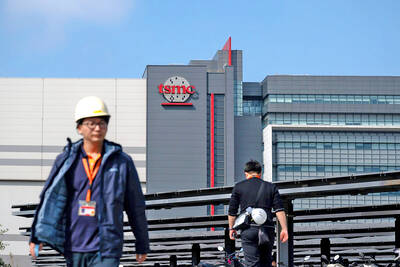The consumer price index (CPI) last month grew 2.14 percent year-on-year, slowing from a 3.08 percent annual increase in February, as the holiday effect on consumer prices ended but other costs continued to rise, the Directorate-General of Budget, Accounting and Statistics (DGBAS) said yesterday.
The inflationary gauge is likely to remain at a similar level this month after a 2.34 percent annual increase in the first quarter, DGBAS official Tsao Chih-hung (曹志弘) said.
“Consumer prices decelerated noticeably from the peaks seen over the Lunar New Year holiday,” Tsao said.

Photo: CNA
This month’s electricity rate hikes would add 0.18 percentage points to the CPI reading, which would rise 2.03 percent this year, he said.
Inflationary pressure is easing, but the CPI is still unable to return to the central bank’s 2 percent target, Tsao said.
Healthcare costs, which usually take a backseat in driving CPI, outpaced other consumption categories last month, increasing 3.19 percent after the Ministry of Health and Welfare removed the limit on registration fee adjustments at medical facilities, the DGBAS said.
The authorities also raised drug prices and copayment rates, it said.
Food costs rose 2.86 percent year-on-year, the DGBAS said, adding that prices of processed food products rose 4.1 percent and dining out costs grew 3.49 percent.
Core CPI, a more reliable long-term price tracker because it does not include volatile items such as energy and vegetables, last month rose 2.13 percent year-on-year, down from a 2.89 percent increase in February, the DGBAS said.
The producer price index (PPI), which measures price movements from a seller’s perspective, increased 0.34 percent, returning to positive growth for the second month in a row, the DGBAS said, citing increases in international oil and gas prices, and the New Taiwan dollar’s depreciation against the US dollar.
Cumulatively, the CPI increased 2.34 percent in the first quarter compared with the same period a year earlier, while the PPI remained in the contraction zone, declining 0.08 percent, the DGBAS said.
In related news, prices for basic goods have risen faster since the COVID-19 pandemic hit than before it, a central bank research report said.
The report found that from 2013 to 2019, before the outbreak of COVID-19, Taiwan’s core CPI grew about 1 percent every 17.19 months, but accelerated to about 1 percent every 7.98 months from 2021 to last year.
The central bank attributed the faster increase in core CPI to the pandemic’s disruption of supply chains, geopolitical tensions and climate change, although the report did not elaborate on how those factors affected Taiwan specifically.
Core CPI rose 1.33 percent in 2021, 2.61 percent in 2022 and 2.58 percent last year, compared with headline CPI increases of 1.97 percent in 2021, 2.95 percent in 2022 and 2.49 percent last year, the central bank said.
It said that many consumers have been skeptical of those numbers, and attributed some of those doubts to a steady rise in dining-out expenses, a common expense for many Taiwanese.
Increases in eating out costs are often resistant to change and could remain stubbornly high, it said.
Taiwan’s CPI could rise 2.14 percent and its core CPI could increase 2.03 percent this year, largely due to an average 11 percent increase in electricity rates, the central bank said.

Apple Inc has closed in on an agreement with OpenAI to use the start-up’s technology on the iPhone, part of a broader push to bring artificial intelligence (AI) features to its devices, people familiar with the matter said. The two sides have been finalizing terms for a pact to use ChatGPT features in Apple’s iOS 18, the next iPhone operating system, said the people, who asked not to be identified because the situation is private. Apple also has held talks with Alphabet Inc’s Google about licensing its Gemini chatbot. Those discussions have not led to an agreement, but are ongoing. An OpenAI

INSATIABLE: Almost all AI innovators are working with the chipmaker to address the rapidly growing AI-related demand for energy-efficient computing power, the CEO said Taiwan Semiconductor Manufacturing Co (TSMC, 台積電) yesterday reported about 60 percent annual growth in revenue for last month, benefiting from rapidly growing demand for artificial intelligence (AI) and high-performance computing applications. Revenue last month expanded to NT$236.02 billion (US$7.28 billion), compared with NT$147.9 billion in April last year, the second-highest level in company history, TSMC said in a statement. On a monthly basis, revenue surged 20.9 percent, from NT$195.21 billion in March. As AI-related applications continue to show strong growth, TSMC expects revenue to expand about 27.6 percent year-on-year during the current quarter to between US$19.6 billion and US$20.4 billion. That would

‘FULL SUPPORT’: Kumamoto Governor Takashi Kimura said he hopes more companies would settle in the prefecture to create an area similar to Taiwan’s Hsinchu Science Park The newly elected governor of Japan’s Kumamoto Prefecture said he is ready to ensure wide-ranging support to woo Taiwan Semiconductor Manufacturing Co (TSMC, 台積電) to build its third Japanese chip factory there. Concerns of groundwater shortages when TSMC’s two plants begin operations in the prefecture’s Kikuyo have spurred discussions about the possibility of tapping unused dam water, Kumamoto Governor Takashi Kimura said in an interview on Saturday. While Kimura said talks about a third plant have yet to occur, Bloomberg had reported TSMC is already considering its third Japanese fab — also in Kumamoto — which would make more advanced chips. “We are

Huawei Technologies Co’s (華為) latest high-end smartphone features more Chinese suppliers, including a new flash memory chip and an improved chip processor, a teardown analysis showed, pointing to the progress China is making toward technology self-sufficiency. The inside of Huawei’s Pura 70 Pro was examined by online tech repair company iFixit and consultancy TechSearch International, finding components made by Chinese suppliers. The firms also found that the Pura 70 phones run on an advanced processing chipset made by Chinese chip foundry Semiconductor Manufacturing International Corp (SMIC, 中芯) called the Kirin 9010, which is likely a slightly improved version of the advanced chip